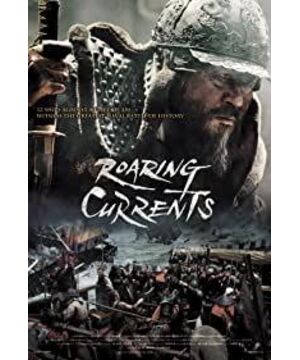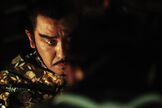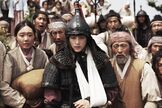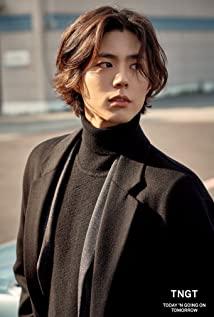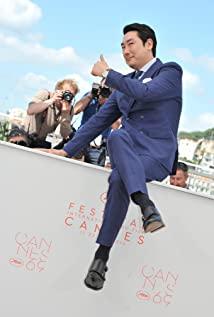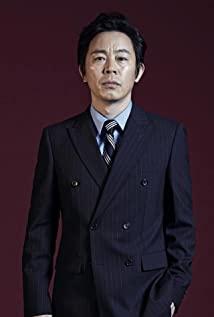.
After watching the movie with great anticipation, I found that this is definitely a typical "stick spirit" anti-Japanese movie. The 61-minute naval battle scene is magnificent and ups and downs. The Korean navy beat the Japanese navy under the disparity of strength. Ye Wen's "one hit ten" is even more bloody. The key point is that this great victory is not an artistic fiction, but a historical reality, so it also gave Korean filmmakers enough confidence to interpret history and show this mythical battle of the weak over the strong in the history of human warfare in a more magical way. In front of the audience, thus creating the most top-level ancient costume naval battle in the history of Asian films so far.
Regarding the North Korean naval admiral Yi Sun-sin who created the miracle of the "Ming Liang Sea Battle", I believe that people who have a little knowledge of Asian history and war history will know his name. People and Koreans are proud of the "God of the Navy". This man's great achievements are linked with a magical "big killer", that is, the "turtle ship", which gives the impression that a modern man walked onto the ancient battlefield with a machine gun and followed the tortoise The ship-to-ship battle of the Japanese warships has one fate - it's over. If the naval battle between Japan and North Korea is a video game, then the turtle ship is a bug-level unsolvable existence. Therefore, the author has a kind of numbness to the miracles in the history of human naval battles created by Yi Sun-sin, but after reading "Ming Liang Sea Battle", I realized that in history, this battle did not exist! Have! turtle! Boat! The North Korean navy used only 14 panok ships to repel more than 300 Japanese warships. Such a miracle of naval warfare cannot but be awe-inspiring, and the colorful interpretation of this miracle has become a source of fascinating plot tension.
The main creator of the film knows very well how to create a hearty war drama, "If you want to promote it first, you should suppress it". At the beginning of the film, Yi Sun-sin, who is shown in front of the audience, is not a shining image of a god of war, but a sad, isolated and helpless sadness. Veteran, under the cloud of inevitable defeat, he tried his best to capture the dawn of victory with all his might. In terms of external factors, the Japanese army was on the verge of collapse, the North Korean army was retreating steadily, and the Japanese navy also had an overwhelming advantage in the number of warships. Commanded by Tosho Kojima, a pirate who has both wisdom and courage. In terms of internal factors, the morale in the barracks had already declined before the battle. Although Yi Sun-sin was the "commander of the three navy forces", his generals had their own ghosts, and he did not have absolute control. At the same time, Field Marshal Kwon-ri also ordered Yi Sun-sin to abandon the naval battle and send all the naval forces to the army. In the process of how to solve this "defeat and critical situation", the characters and plots began to shine. The Korean movie star Choi Min-sik's Lee Sun-shin first showed the city in his chest. Forcefully suppress, but express their stance that they will never back down with silence and persistence. Second, he showed his belief in victory. Although the strength of the two armies was very different, he still actively prepared for battle, inspected the battlefield, and thought about all possible ways to overcome the enemy and win. If the above two aspects are to show his "big hero" temperament, then the film also shows his guilt and anxiety, which is shaped by the humanization close to the audience. In order to stimulate the morale of the same enemy, Yi Sun-sin deliberately sent a reconnaissance ship After going out to sea, he was killed by the Japanese army, cut off the heads of all the officers and soldiers of the ship and sent them back. In the middle of the night, Yi Sun-sin seemed to see a ghost coming to complain. At this time, he was just a grief-stricken old man, not a cold and determined general. Of course, this humanized weakness is out of place in the face of a brutal war, and only Yi Sun-sin's heroic temperament can turn things around. Therefore, the film further focused on this aspect. Yi Sun-sin released three "nirvanas" internally. One was "killing chickens to warn the monkeys", beheading the deserters without saying a word; the other was "breaking the cauldron and sinking the boat". The fire burned their barracks and fodder, cutting their way back. The third is "death and then live", which is what the film said "fear will make people fail, but fear will also become the spiritual force of victory", and his way of "turning fear into bravery" is to transform his own The battleship in command was on the front line against the Japanese army. Through his bloody battles and sacrifices, he aroused the bloody blood and courage of the officers and soldiers on the other warships who were watching.
Externally, Yi Sun-sin also released three "nirvana skills". First, he made full use of the current and vortex of Mingliang Strait, first anchored in the center of the strait, and used violent and accurate artillery fire to attack the incoming Japanese warships head-on. Then, using the small island in the heart of the river as a barrier, they fought bloody hand-to-hand combat with the Japanese warships that came from the siege, and used close-range artillery bombardment to shatter the Japanese warships. The second is the time of day, taking advantage of the time when the Mingliang Strait began to generate a huge vortex, and once again placed the warships in the middle of the strait to block the way of the Japanese army, attracting the main force of the Japanese forwards to start a decisive battle in the great vortex with no return. The third is people, Yi Sun-sin's "fear tactics" finally came into effect, and all the other warships waiting to see finally plunged into the battlefield with the courage of one to ten, and rushed to the main fleet of the Japanese army. As for the Japanese army, it was "people and negative points". Coach Tontang Gaohu first "sit on the mountain to watch the battle between Laishima Tonghao and Yi Sunsin." With the belief in a decisive battle, they can only retreat in a hurry.
"Ming Liang Sea Battle" has twists and turns at the plot level and is fascinating. On the sea battlefield, it is full of high-energy, exciting and refreshing. The special effects scenes and action design have reached the highest level of today's Korean films and even Asian films of ancient costume wars, showing shocking audio-visual The effect, burst out the hearty passion. There is a tactical battle of wits and courage between Yi Sun-sin and Kojima Tonghao, the fierce and fierce gunfights between the two warships, and the bloody and brutal hand-to-hand combat between the Japanese army boarding the ship and the North Korean army. Since there are historical facts, the creators of the film are extraordinarily "willful" when they shoot naval battle scenes. Naturally, Yi Sun-sin has all kinds of openings, and the guns are the most accurate. Under a few rounds of salvos, the Japanese army has three or four warships. falling apart. The arrow is the most accurate, and the film specially designed a small detail of the "opening duel": a sharpshooter under Kojima Tonghao shot and killed the North Korean water who tried to raise the signal flag with an arquebus several hundred meters away. The army almost killed Yi Sun-sin with a gun, but he was shot in the eye with an arrow by one of Yi Sun-sin's archer officers, and he rolled off the boat and died. People are the best at fighting. The Japanese army surrounded Yi Sun-sin with three ships, and the Japanese army jumped on Yi Sun-sin's warship to besiege three ships, but they were still defeated by the North Korean army with full of courage. Luck was also the best. Using the method of perishing with the enemy ships to death, but always able to turn the corner, and finally the warship lost control and was involved in the maelstrom, and the people used fishing boats to pull back. Yi Sun-sin himself also instantly burst into the crit halo of "Anti-Japanese Hero". Facing Kojima Tong, who rushed to his life, he chopped off his head with a knife, and the corpse knelt down in front of Yi Sun-sin, a catharsis of national emotions. At the peak, it is no wonder that the Korean people are so enthusiastic about the film.
View more about The Admiral: Roaring Currents reviews


